Once again we arrive at the end of March and, for several years now, this period belongs to Huawei and his P-series smartphones. Smartphone photographers especially look forward year after year to Huawei's latest photographic miracle. But this year, Huawei not only gives the P40 Pro a new design, a new interior and a camera setup that is second to none, but also takes the path to independence from Google. Here is my first hands-on review of the Huawei P40 Pro.
Huawei P40 Pro release date and price
The P40 models are not yet available on the open market, which is also due to the current situation. As usual, pre-orders should open on the day of the show, but it will take a few more weeks until the Huawei P40 and the P40 Pro are available in stores. Huawei states that advance sales will continue until May 1 and delivery will start on May 2. This is not so much due to production difficulties, but more to some important partners from the high street, who have closed all shops and do not know exactly when they will be able to open them again.
Both the Huawei P40 and the P40 Pro will be available in three high-gloss color variants: Ice White, Black, and Deep Sea Blue. Additionally, there will be two matte color versions called Silver Frost and Blush Gold. In some regions, Huawei has decided to offer only three of the five color versions. The P40 Pro starts at €999 ($1,090). The Huawei P40 with its flat 6.1-inch display costs €799 ($870).
In the second half of the year, Huawei will push the P40 Pro+, the non-plus-ultra camera smartphone into the race, which is identical to the P40 Pro tested here except for the camera on the back. Like Samsung's S10+ last year, the Huawei P40 Pro+ has a scratch-resistant ceramic back and Huawei has also added a second telephoto unit to the P40 Pro+, allowing two fixed focal length cameras, one with 3x optical magnification and one with a periscope lens with 10x optical zoom. Huawei calls this double telephoto unit SuperZoom Array, but has not yet given us an exact date and price for the phone.
Huawei P40 Pro design and build quality
Huawei has always attached great importance to a chic case for his P-Series and the P40 Pro also has a very nice design. On the back, the camera hump has unmistakably grown to a real island. But just this island and the landscape-aligned lettering reminds me very much of old Sony compact cameras like the Cyber-shot DSC-TX30. This is intentional, because smartphones have almost replaced compact cameras.
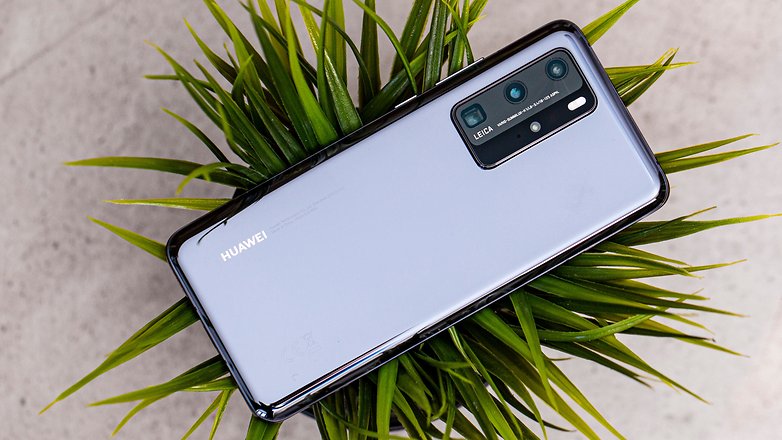
The layout of the entire smartphone is strongly geared towards using it as a camera. All buttons are located on the right side, so that they are on top when taking photos or shooting videos. Huawei said that all of this has been designed so that the smartphone is always secure and grippy in the hand. Especially when you hold it in your hands the way you do when taking pictures. In fact, the Huawei P40 Pro sits beautifully in the hand and is easy to hold. Too bad we only got the high gloss P40 Pro in black. Due to the matte finish, the gold and silver color variations could be even more grippy and feel better in your hand. In addition, they would not be covered with fingerprints as quickly as the black model.
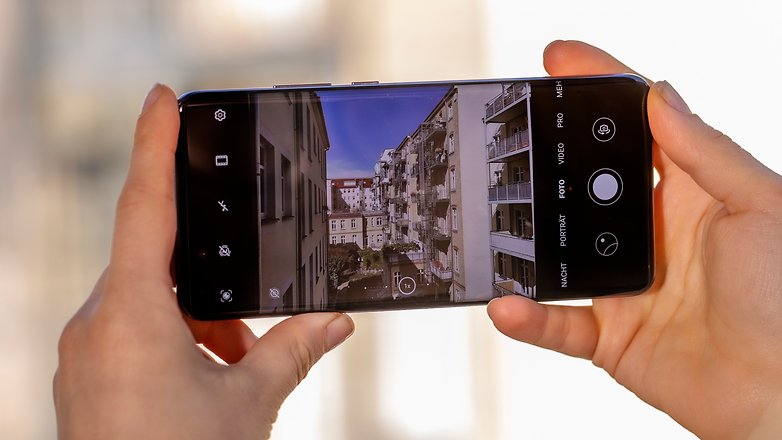
The four-sided Edge Display
The new display design of a smartphone now includes a new hole-punch for the integration of the selfie camera. Huawei's P40 Pro comes with a pill-shaped cutout this year. This not only contains the two front cameras, but also an IR Blaster, which supports the 2D face unlocking in low light conditions.
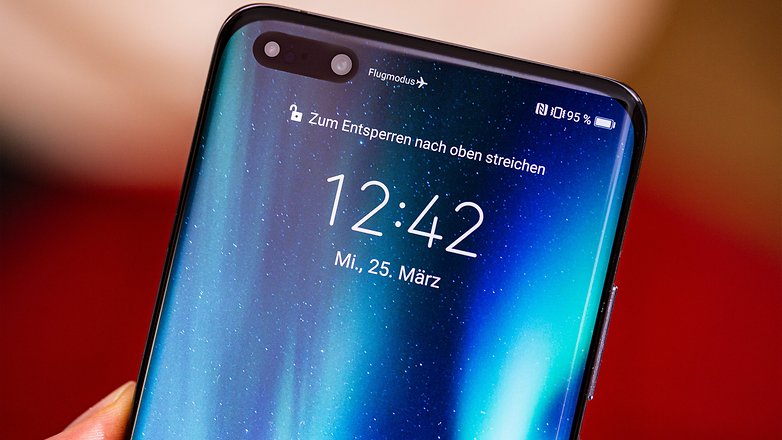
But the edges at the upper and lower edge of the display of the Huawei P40 Pro are noticeable. Until now, these were flat and straight on all smartphones, whether with edges bent over the sides or not. The Huawei P40 Pro has a small radius that bends towards the frame of the housing. Huawei's beautiful marketing name for the display is 'Quad Over Flow Display'. A small bend in the display I can see, but it is not as pronounced as on the sides.
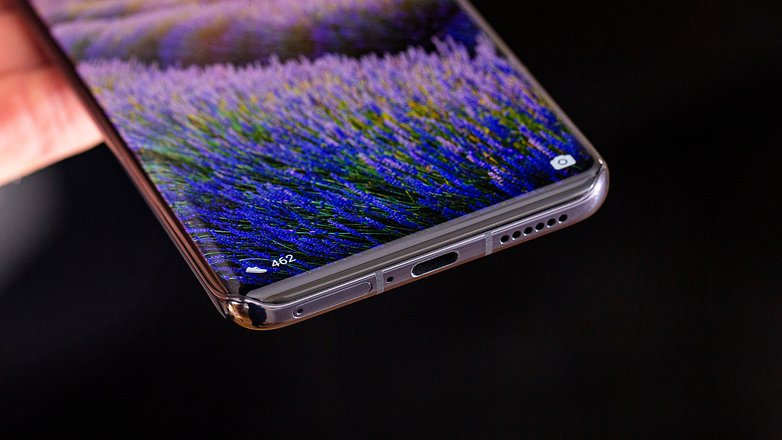
Technically, Huawei has installed a 6.58-inch AMOLED panel with a resolution of 2,640 x 1,200 pixels in the P40 Pro. In addition, the panel is capable of outputting both 60Hz and 90Hz refresh rates, and the display makes a bright, colorful impression during my first hands-on.
Android 10 without Google apps and services
Huawei uses EMUI 10.1 based on Android 10 for the P40 Pro, as it did for the Mate 30 Pro and Huawei Mate Xs, so updates and security patches won't cause any problems. Huawei Mobile Services, which run entirely on the P40 Pro instead of Google Mobile Services, looks somewhat different. At first, you can give the all-clear: WhatsApp, Facebook, and Twitter all run on the Huawei P40 Pro. You can simply download the apps either the Huawei App Gallery, as in the case of Facebook and WhatsApp, or refer to the manufacturer's pages and download the APKs there. A third way, as is the case with Twitter, is quite clever and stores the mobile websites as quasi HTML5 apps that can then be used via the Quick Apps feature.
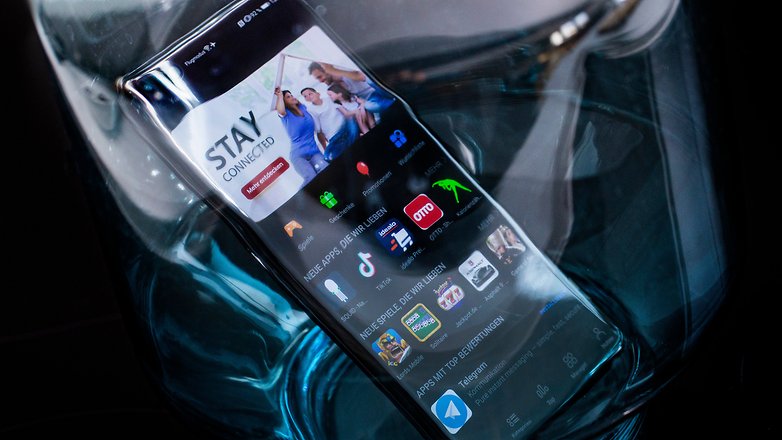
Huawei Mobile Services, which is only a few weeks old outside of China, is not yet running smoothly. Making the move via the Phone Clone App, which according to Huawei can also transport data like WhatsApp chat histories to your new P40 Pro, failed completely. Also I can't play my current favorite games like Star Trek Fleet Command and Shadowgun War Games on the P40 Pro, because they are not available in the App Gallery and are also synchronized via Google Play Services. But it is also a huge task for Huawei to convince the developers of HMS Core and its SDKs and APIs. Whether Huawei will be successful here, time will tell.
Fast chip with integrated 5G modem
Inside the Huawei P40 Pro, the in-house Kirin 990 5G SoC is used. This is already used in the Huawei Mate Xs and Huawei Mate 30 Pro. There is also 8GB of RAM and 256GB of internal storage, which can be expanded with the help of a Huawei Nano Memory Card. With this combination of powerful hardware, the Huawei P40 Pro should be more than ready for all everyday smartphone tasks.

However, a small hidden feature is interesting: the P40 Pro's dual SIM feature. You have the choice of whether to use a physical SIM card instead of a Nano Memory Card, or you can use an eSIM if you want to keep your expandable storage. That's right, also Huawei finally gives you the option to use an eSIM in 2020. Great!
A technically complex camera
Huawei pursues a single goal with its smartphone cameras: best-in-class quality for everyone. Everyone who has a Huawei P-series smartphone should be able to get the best possible results in the simplest possible way. Therefore Huawei pushes the camera setup of the P40 Pro even further and calls it UltraVision Quad Camera. This consists of the following components:
- Main camera with a 50-megapixel image sensor, f/1.9, optical image stabilizer
- Ultra-wide-angle camera with a 40-megapixel sensor, f/1.8, optical image stabilizer
- Periscope telephoto camera with a 12-megapixel image sensor, 5x optical zoom, f/3.4, optical image stabilizer
- ToF camera for 3D depth information
Huawei does not use an RGB mask for all three image sensors, but the in-house RYYB mask. By exchanging the green pixel for yellow, better light sensitivity is available. It is also interesting that Huawei has an optical image stabilizer in all three lenses. These can not only help with photos, but also with videos. Especially in the video area, Huawei wants the P40 Pro to have more quality than the P30 Pro, which is heavily trimmed for photography.

Actually, our hands-on time was not enough to test the full capabilities of the Huawei P40 Pro camera. Moreover, one has to realize again and again that all manufacturers, even after the sales start with updates, will quickly eliminate the errors and bugs. This will certainly be the case with the P40 Pro and its sister models. In any case, we will be happy to provide you with an extensive camera test of the Huawei P40 Pro in the coming weeks.
A battery with potential
For enough juice on the go, the rechargeable battery Huawei relies on is one with 4,200 mAh capacity. If it runs out, it can either be charged by cable with Huawei's 40-Watt SuperCharge power supply, or it can also be charged wirelessly with 27 Watts. The Huawei P40 Pro also supports reverse wireless charging, even if it is only useful for wireless headphones.
How well the P40 Pro with its 4,200 mAh battery performs along and how hungry for power the Kirin 990 including the 5G modem is, plus the 90Hz display and the elaborate camera system, we will find out for you in the next few days and weeks. We will provide the results in our final review.
Early Verdict
When it came to hardware, Huawei was not stingy and has put everything that the company had on its shelves or could develop from scratch into this device. Also in terms of the operating system, EMUI 10.1, you get a package that has already been evaluated a million times. But Huawei is breaking new ground with Huawei Mobile Services. This combination of the App Gallery, Cloud Services, the Core System and other services like Huawei Music and Video, has to prove itself over the next few months and become a comprehensive and strong alternative to Google services as soon as possible. So the success of the Huawei P40 Pro and all other smartphones from the Huawei and Honor alliance is heavily dependent on the ecosystem that the Chinese manufacturer now has to build outside of China in the form of HMS.
Read More Open link https://ift.tt/2yb9Cmq
0 Response to "Huawei P40 Pro hands-on review: the new photo miracle maker"
Posting Komentar